Reports
The Fordow Enrichment Plant, aka Al Ghadir: Iran’s Nuclear Archive Reveals Site Originally Purposed to Produce Weapon-Grade Uranium for 1-2 Nuclear Weapons per Year
by David Albright, Frank Pabian*, and Andrea Stricker
March 13, 2019
PDF file of report
Al Ghadir Annex I
Al Ghadir Annex II
For a summary of this report, click here.
A surprise in the Iranian “Nuclear Archive” seized in early 2018 by Israel in Tehran was a picture showing support facilities for a gas centrifuge enrichment plant. The plant later became known as the Fordow Fuel Enrichment Plant (FFEP), located near Qom (Figure 1). Geospatial information and analysis show that this image from the archive, also called the “Atomic Archive,” can be dated to 2004 or earlier. The archive information shows that construction started on this once-secret plant as early as 2002, and that it was being built to produce weapon-grade uranium as part of Iran’s nuclear weapons program, a program the Iranians codenamed the Amad Superorganizational Plan. Documents in the archive show that this facility was designed to make weapon-grade uranium starting with low enriched uranium (LEU), and not natural uranium, making the program dependent on uranium enrichment plants being built by the Atomic Energy Organization of Iran (AEOI) or the procurement of an unsafeguarded supply of LEU from abroad. Based on a document in the archive, the military enrichment plant was expected to produce enough weapon-grade uranium, using LEU feedstock, for at least one or two nuclear weapons per year.
The image in Figure 1 refers to the Al Ghadir project, which is a code name for this enrichment project. Al Ghadir has special meaning for the Shia as the place (Ghadir al-Khumm) where the prophet Mohammad established the imamate and the governance of god, according to Iran’s Supreme Leader. 1 The true spirit and meaning of Islam for the Shia exists in the event of Ghadir. 2 That a project to make weapon-grade uranium for nuclear weapons is called Al Ghadir appears contrary to the widely repeated Supreme Leader fatwas that state that the production, stockpiling, and use of nuclear weapons are forbidden under Islam and that the Islamic Republic of Iran shall never acquire these weapons. 3 Of course, many military and civilian products are also called Ghadir, but reserving this name for what is by all accounts the “long pole” in the tent of any nuclear weapons program is worth noting.
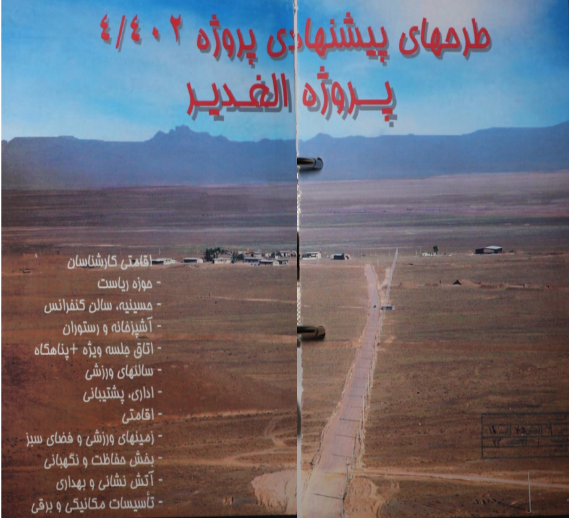
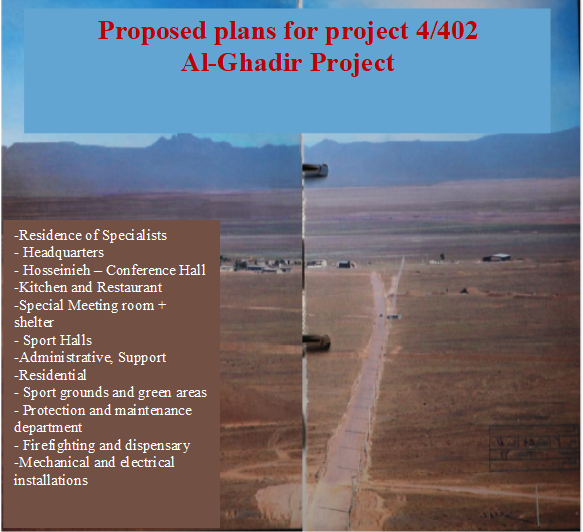
Figure 1. The Al Ghadir Project Site, project or 4/402, or 4.402, where project 4.4 is a later Amad designation for the centrifuge project. The “02” appears to be a subproject. Satellite imagery and geospatial analysis shows that this site is the support complex of the later named Fordow enrichment plant (see Figure 3). It should be noted that “/” in Farsi translates to a decimal, “.” in American English.
In September 2009, after this site was discovered by Western intelligence, Iran declared it to the International Atomic Energy Agency (IAEA). Iran subsequently told the IAEA that it had not started construction of the plant until 2007, claiming to have repurposed an existing military underground site on an Islamic Revolutionary Guard Corps (IRGC) base. The archive information proves this claim to be false.
The archive does not contain information on the fate of the plant after the Amad project was reoriented in 2003. However, information from the IAEA inspection effort suggests that in 2009, the plant was still being built to produce weapon-grade uranium, until it was exposed and subsequently modified to make LEU under international pressure. At a minimum, this secret plant gave Iran an option of producing weapons-grade uranium without the international community knowing about it.
Iran vehemently denied that this plant had ever been designed to make anything other than LEU. In 2009, Western powers did not have evidence to refute this claim, choosing to characterize the plant as nuclear weapons-capable. Inspector concerns and suspicions were not made public at the time. Only now, with the new evidence in the archives, can a more accurate picture of this uranium enrichment plant be developed. Nonetheless, there remain many questions, which only Iran can answer, something it should finally be expected to do.
Early Military Centrifuge Effort: The Physics Research Center
The Iranian military’s interest in gas centrifuges can be traced to the late 1980s, based on statements of Iranians who were part of the AEOI centrifuge program at the time and learned of the parallel military centrifuge effort. 4 At the time, the Iranian leadership likely created the military nuclear program and coordinated its work with the AEOI, which was also operating a variety of nuclear facilities associated with civilian nuclear energy. It is unknown how the top leadership of the regime at the time coordinated these programs in practice, and what their respective roles were in developing nuclear weapons.
Additional evidence for a military centrifuge program dates to the foreign procurement efforts of the Physics Research Center (PHRC) in the late 1980s and early 1990s, which was the organization created in the late 1980s by the Iranian leadership to pursue a military nuclear program. Based on assessing a set of over 1,500 telexes of the PHRC, aimed at purchasing equipment and technology from abroad, our Institute concluded that the procurements associated with “Department 2” of the PHRC were associated with a secret, military gas centrifuge program. 5 Moreover, according to the Institute’s 2012 report on the telexes:
The centrifuge effort appears to be early in nature rather than associated with a mature program. These procurements do not appear to be for AEOI, and Iran does not claim this in any case. It would be a difficult case to make. In 2003, the AEOI allowed the IAEA to inspect its centrifuge equipment and materials at its major centrifuge facilities, and the IAEA generated extensive lists of equipment and learned when much of it was procured. Most of these goods were purchased in the late 1980s and early 1990s by known AEOI officials through several European companies, before PHRC started its procurements. Thus, the equipment attributed to Department 2 is unlikely to be for AEOI’s centrifuge program. 6
Amad Plan
In the late 1990s, Iran reorganized and energized its nuclear weapons program with the establishment of the Amad Plan. A table in the archive, dated to 2002, lists the major parts of the Amad Plan. Labeled number 2 in the table is the centrifuge project; it started on October 2, 1999 and planned to finish building all facilities and associated activities on March 18, 2004. Its major constituents, as numbered in the table, were:
2.1: The industrial model, October 3, 1999 to March 18, 2002;
2.2: Feed system construction, October 2, 2000 to May 21, 2002;
2.3: Pilot plant, starting in March 21, 2001 and being finished on March 18, 2002; and
2.4: The plant, starting September 23, 2001 and being finished on March 18, 2004.
At the time when the table was prepared, sometime during the first half of 2002, the industrial model was listed as 70 percent finished, although expectations were that it would be 91 percent finished by that time. The pilot plant was four percent finished versus 38 percent expected. The plant was zero percent finished versus 10 percent expected to be finished by this date.
The location and size of the Amad pilot plant is unknown. However, planning and perhaps even some construction had likely started by the time the table was prepared. Moreover, this plant may have involved a relatively small number of centrifuges.
The table makes clear that the Amad plan included a schedule to build an enrichment plant that was originally expected to be finished in late winter 2004, namely the Al Ghadir project. This schedule means that Iran’s later declaration to the IAEA of starting this facility in 2007 is not only incorrect, but deliberately false.
The archive has a video that may show an industrial model being developed by the Amad Plan, or its predecessor, the PHRC. Figure 2 shows a freeze-frame from this video of a line of five centrifuge housings, absent rotor assemblies, in an unidentified building. The entire video shows two lines of centrifuge housings in this room.
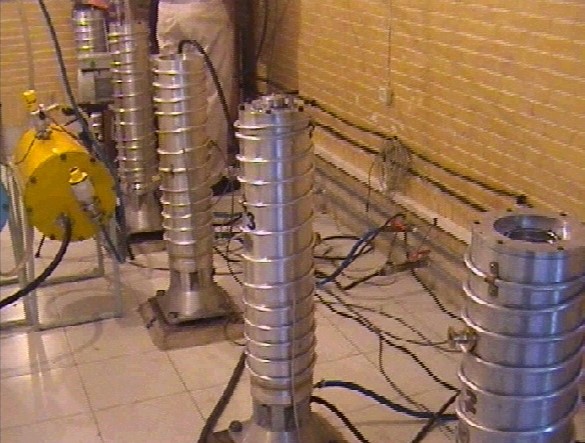
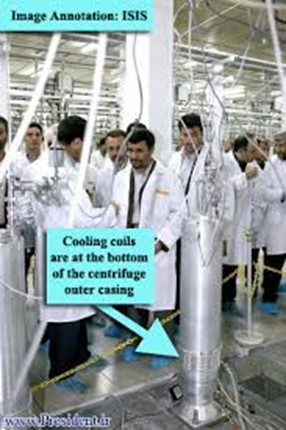
Figure 2. On top, a photo, captured from an Iranian video in the archive, of individual centrifuge stands in an unknown facility. The stands do not appear to contain centrifuge rotors. On bottom, a photo of a possible IR-2 type centrifuge, which appears wider than the ones on the top, based on comparing its width to people nearby.
Based on IAEA reports, the tiled, relatively small room does not appear to be at the AEOI’s Kalaye Electric centrifuge research and development facility in Tehran or at the AEOI Natanz enrichment site. Moreover, the centrifuges do not match the IR-1 centrifuge and their diameter appears narrower than those typically associated with IR-2-type centrifuges. The latter is based on designs of what is called the P2, a Pakistani design provided to Iran in the 1990s, and has an outer diameter of about 22 centimeters and was initially developed by an Iranian engineer called “Fard.” Although Iran’s declaration was that Fard was part of the AEOI centrifuge program, that assertion may in fact not be the case. A leading possibility is that these centrifuges in the figure were being tested at a military facility, either under the Physics Research Center or subsequently under the Amad Plan, in parallel to the AEOI centrifuge program. However, it could not be determined whether this room was at Fard’s workshop, which was separate from the two AEOI sites mentioned above.
IAEA reports are consistent with the schedule in the above-mentioned table where work on these military centrifuges was occurring in 1999, with experimental work going back earlier. Several years prior to the seizure of the archive, IAEA reports included that inspectors had not been successful in identifying where any military centrifuge work happened.
The exact relations between the military and AEOI centrifuge programs in the 1980s and 1990s are not well understood publicly and need to be clarified. One anecdotal piece of information is from former members of the AEOI centrifuge program during that time who described cases where the military program had “first look” at any information acquired from the Khan network, according to a former member of the AEOI centrifuge program. 7 In practice, this worked by military officials taking centrifuge designs brought back to Tehran from abroad and then returning them later to the AEOI centrifuge team.
The schedule laid out in the table for the Amad centrifuge program appears to have been far too ambitious. Moreover, it was clearly disrupted by the U.S. invasion of Iraq and the intensive IAEA inspections that started in Iran in 2003.
Project Numbers
So far, two different project numbers, plus the code name Al Ghadir, for the military centrifuge program have been discussed. As is the case for other projects in the Amad project, numbering varies, or more accurately, evolved over time. Department 2 appears to originate in the time of the Physics Research Center in the 1990s but also appears to have been carried over to the Amad Plan, since the above-mentioned table lists parts of the centrifuge program as number 2. An alternative, later Amad project numbering system lists the centrifuge program as project 4.4, where “4” connotates uranium enrichment. For example, project 4.8 is the laser enrichment project. Digits after the 4.4, as is the case of 4.402 shown in Figure 1, are likely a way to reflect subprojects of the centrifuge program. It should be noted that clarity was likely not a main goal, since the fuzzy designations served to add confusion to the task of Western intelligence and the IAEA in trying to make sense of the limited amount of information they had each acquired about the secret nuclear weapons program.
Goal Quantities of Enriched Uranium
Another table in the archive, dated to about 1999 or 2000, and published in a previous Institute report, gives an idea of the amount of enriched uranium sought by the military nuclear program. 8 This table lays out a schedule to build five nuclear weapons and be prepared to test one. In a footnote to the table is listed a requirement for 200-250 kilograms of enriched uranium, which is interpreted as weapon-grade uranium. At the time when this table was written, which was part of a senior-level approved plan, Iran considered foreign purchase or domestic production of the enriched uranium needed for the nuclear weapons. This information suggests that Iran would not have stopped after building five nuclear weapons. At 15-20 kilograms per nuclear weapon, 200-250 kilograms of weapon-grade uranium is enough for 10-16 nuclear weapons.
Al Ghadir Project
As can be seen in Figure 1, project 4.204 of the Al Ghadir project had a range of support facilities. Geospatial analysis correlates this site to the support facilities for the enrichment site near Qom identified by Western powers in October 2009 and later called the Fordow enrichment plant (see Figure 3). The imagery in Figure 3 shows that this site was well under construction by mid-2004. Figure 4 shows a closeup of the tunnel complex in June 2004.
Quoting IAEA findings based on satellite imagery and member state information, Reuters reported in 2009 that construction of the plant dated to 2002.9 This date is a little later than the September 2001 start date given in the table discussed above; it may simply reflect the delay in the construction schedule, as indicated in the table above.
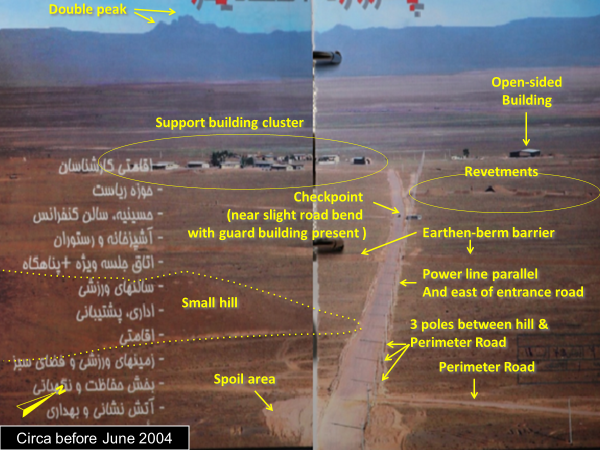
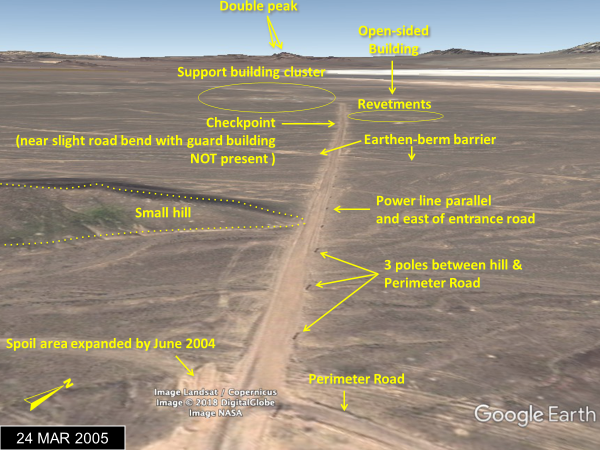

Figure 3. Correlating the Al Ghadir support building construction site with the Fordow centrifuge plant.
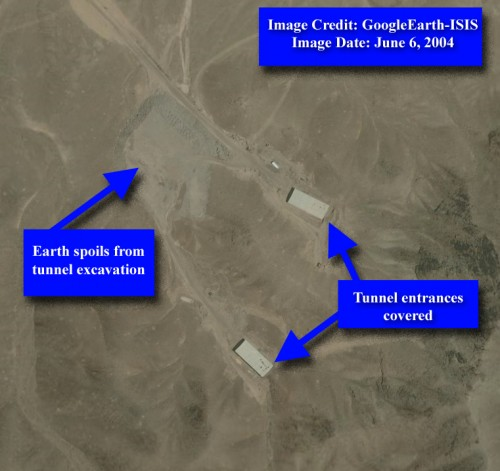
Figure 4. The covered tunnel entrances of the enrichment plant as of June 6, 2004. See also Figure 3.
Figures 5 and 6 show design schematics from the archive of the underground portion of the plant; all the documents trace to before about 2004, according to Israeli officials who briefed Albright. Figure 5 shows a long underground hall that is 250 meters long by 13 meters wide and is the planned area for the centrifuges. A striking feature is the blast/debris traps designed (see Figure 5) to mitigate blasts into the tunnel from aerial bombardment of the tunnel entrances. It is further evidence of the intent to protect the complex and help ensure its operational survival. Figure 7 is a composite showing the plans in Figures 5 and 6 for the underground site overlain on a Google Earth image (see also Annex 1 for additional analysis). The schematic matches the entrances and expected layout of the deeply buried Qom uranium enrichment plant. 10
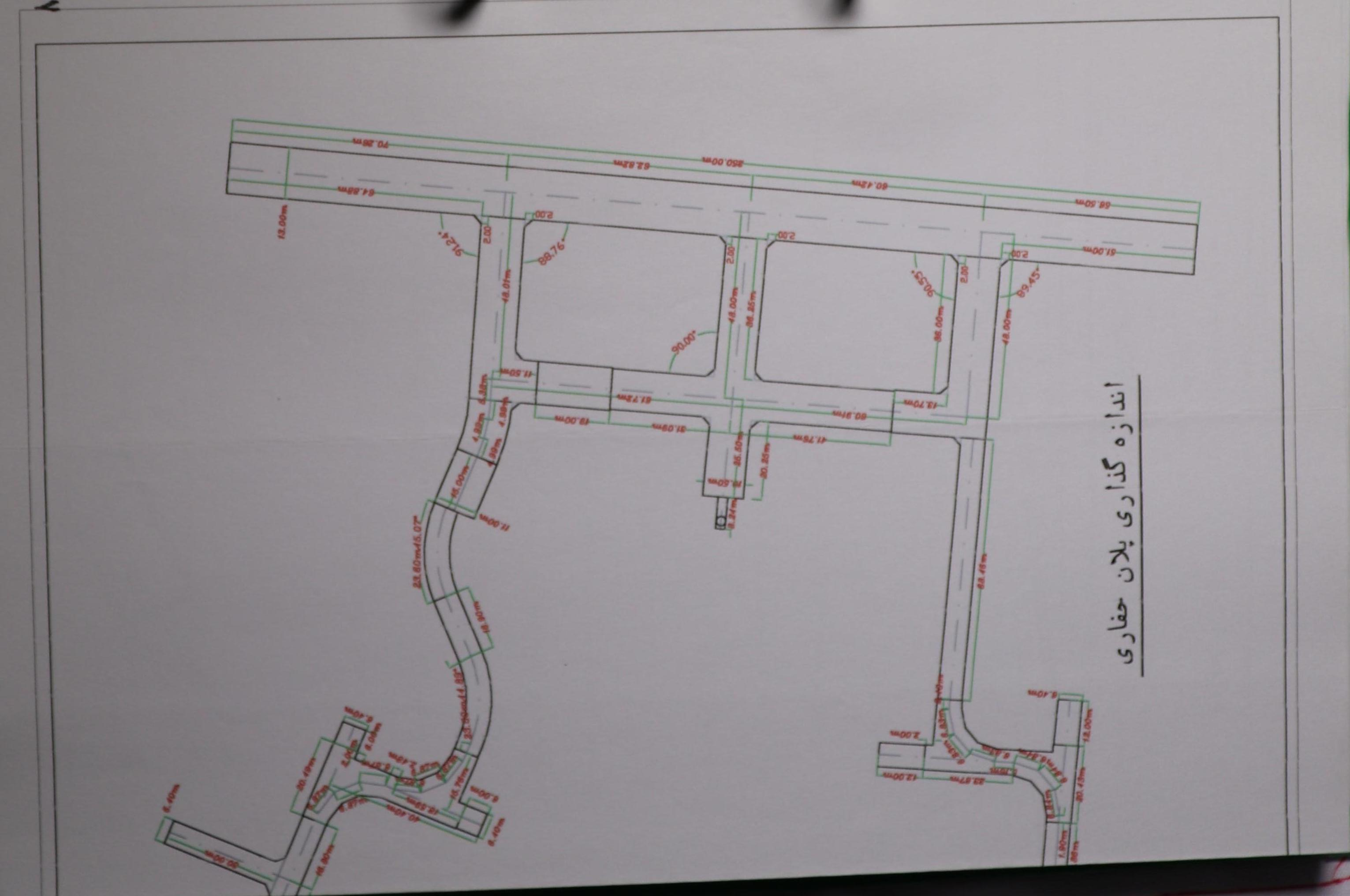
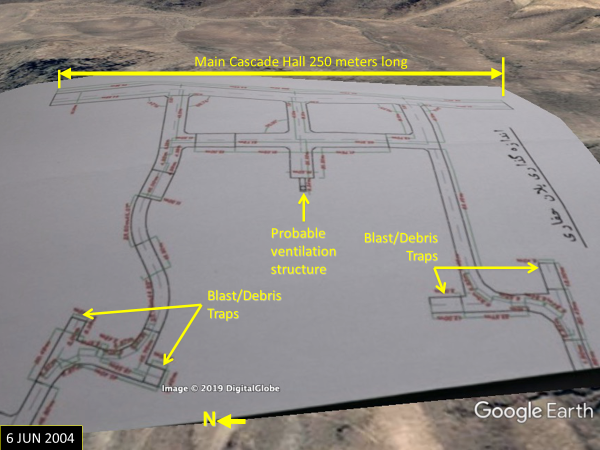
Figure 5. A tunnel diagram of the Al Ghadir project from the archive and its overlay on a Google Earth image (see also Figure 7 and Annex 1). The Farsi on right states, “Plan Measurement for Drilling.” Note the blast/debris traps designed to mitigate blasts into the tunnel from aerial bombardment of the tunnel entrances.
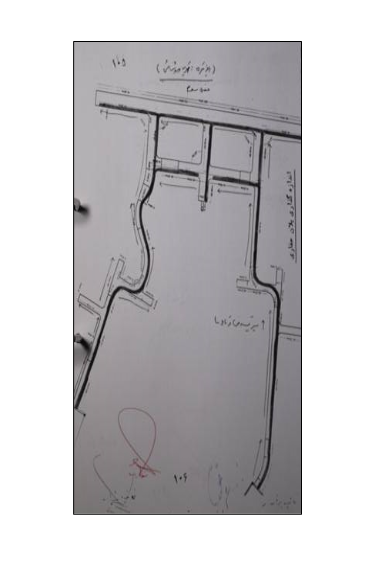
Figure 6. A signed design drawing of the underground enrichment plant, where the caption on the right side says in Farsi, “Measurement of the Excavation.” The number at the bottom near the signatures is 106 and 105 is at the top; possibly one is a page number. On the top, it reads “Chapter 3.” There is also handwriting at the top and in the middle of the drawing, which is illegible.
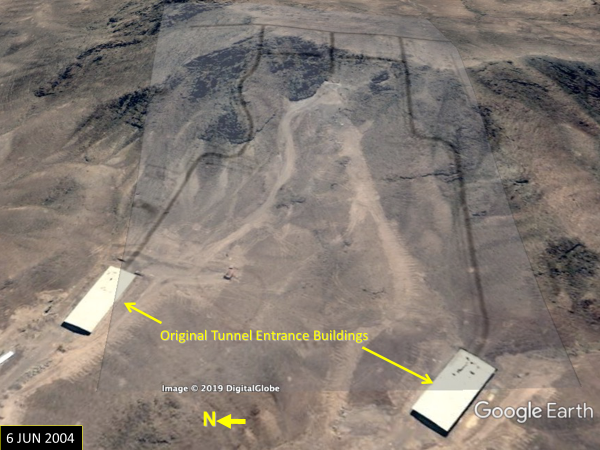
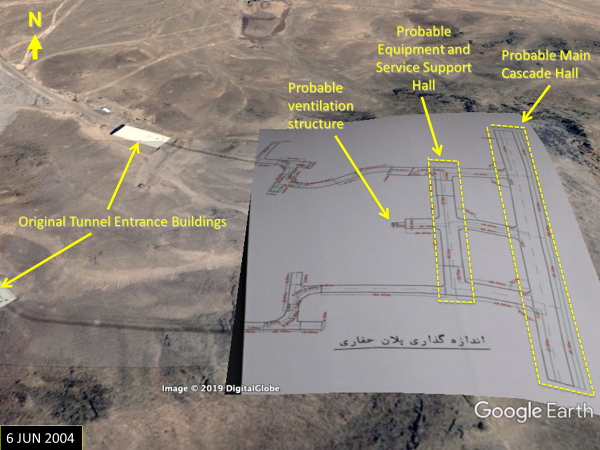
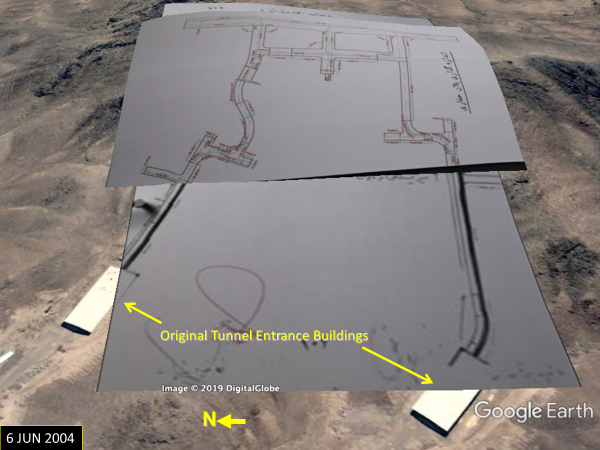
Figure 7. Tunnel diagrams from archive overlaid on a Google Earth image, showing how the tunnel entrances line up.
Weapon-Grade Uranium Output
The archive contains evidence that the Al Ghadir site was intended to make weapon-grade uranium. In the early part of the Amad program, according to Israeli briefers quoting handwritten archive material, the initial plan was to make weapon-grade uranium starting with natural uranium. 11 However, this plan shifted in 2001.
One document in the archive is a draft to be signed by the head of the AEOI, then headed by Reza Aghazadeh, and the Iranian Defense Ministry, headed then by Ali Shamkhari. The document is undated but the Israelis assessed that it is likely from 2001. 12 The document orders the transfer of responsibility, and required information, methods, and budget, from the AEOI to the Defense Ministry for the task of further enriching uranium hexafluoride from three percent to over 90 percent, or weapon-grade (see Figure 8). By skipping the step of making three percent enriched uranium, annual production of weapon-grade uranium at this facility would roughly triple.
The transfer to the Ministry of Defense included “all the schematics, scientific and professional documents and original samples relating to the project,” and an agreement for “cooperating and helping make accessible the information, work performed and methods used by the Organization.” This part of the contract confirms that the AEOI centrifuge program had become more advanced than the military one.
The AEOI also agreed to supply the three percent enriched uranium, although the contract does not state where it would come from. One possible LEU source could have been its then secret Natanz enrichment plant or another later abandoned site (see below). The onward enrichment, or that beyond three percent and eventually to weapon-grade, would have been envisioned to take place in the Al Ghadir facility.
The agreement suggests that originally the AEOI was also planning to make weapon-grade uranium, by stating that the AEOI was “transferring to the Ministry of Defense its task of enriching UF6 by centrifuges from 3% to over 90%” (emphasis added). Where that enrichment would have occurred is unclear. Natanz is a possible candidate, which at the time Iran was building in secret, but was exposed in late 2002. Another AEOI site that deserves further scrutiny is called Farayand Technique, which is located in an industrial park in a valley near Esfahan. 13 According to former senior U.N officials close to the IAEA, inspectors who visited this site between 2003 and 2006 suspected that the site could have been originally intended as a back-up to the AEOI’s Kalaye Electric facility or perhaps even as a pilot centrifuge plant distinct from the Amad pilot centrifuge plant. At the time, the Farayand site had two centrifuge test stands and a test pit, which would have been capable of mechanically testing centrifuges. Next to this facility was a large building under construction, which may have been intended to be the AEOI pilot centrifuge plant before the decision was made to establish its centrifuge pilot plant at Natanz, which was built to hold up to 1000 gas centrifuges. Moreover, the Farayand building was far larger than the building that housed the pilot centrifuge plant at Natanz. According to former senior United Nations officials close to the IAEA, there remain questions about the original intended role of the Farayand site as a research and development facility but also as a pilot plant able to produce significant amounts of LEU. Based on the archive information, a new question is whether the Farayand site was also part of an early AEOI plan to make weapon-grade uranium; a step abandoned once the responsibility for making weapon-grade uranium was taken over by the Amad program and the Al Ghadir project.
This document implies that by the late 1990s or early 2000s Iran had decided to concentrate the production of weapon-grade uranium in the Amad program, but ensure that this effort would utilize the AEOI centrifuge program. The decision called for a deeply buried site less vulnerable to military attack than the Natanz site.
The links between the Ministry of Defense and the AEOI can also be seen in the centrifuge manufacturing complex. Centrifuges have to be made by the thousands. Despite needing extensive foreign assistance, Iran’s centrifuge program still needed to be able to manufacture centrifuge components on its own. Prior to 2004, the military-run 7th of Tir Facility made the most sensitive centrifuge components, namely the rotating ones, for the IR-1 centrifuges. In general, the IR-1 key centrifuge components were overwhelmingly made by Ministry of Defense contractors. 14
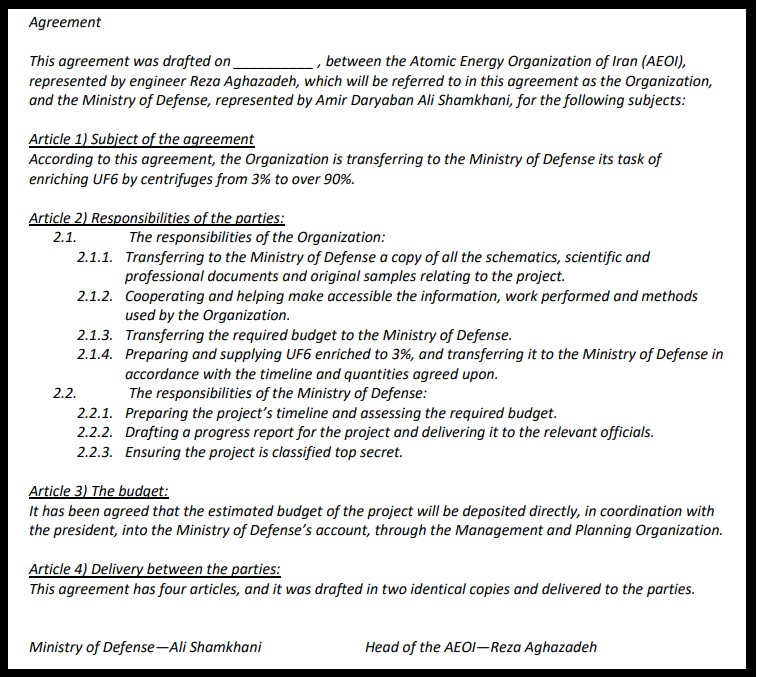
Figure 8. Agreement from the Nuclear Archive Obtained by Israel in Tehran (translated from Farsi). Authors’ Note: Original document in Farsi is in Annex 2 to report.
The archive contains multiple centrifuge cascade layouts for the plant prepared during the planning of the Al Ghadir project under the Amad Plan. Each layout examined a variation of the floor plan of the tunnel complex. 15 Figure 9 shows one of these documents, which was given to the media; we obtained it from them. It appears to show the number of centrifuges that can be packed into a rectangular area of 10 by 228 meters, which corresponds to a major fraction of the long rectangular portion of the Al Ghadir plant seen on the far right of the tunnel complex in Figure 5. This alternative is labeled as option A; an option B is the same except it has a width of 12 meters, according to the Israeli briefers. The tunnel diagram in figure Y shows a width of 13 meters, possibly implying still other options. In general, these layouts represent early planning and not final designs for placing cascades in the tunnel complex.
Option A appears to show cascades with four centrifuges across (represented by small round circles in the “magnified” section). Each cascade has an overall dimension of two meters by 21 meters. Based on there being four centrifuges across the two meter stretch at the ends of the cascade and the centrifuges being uniformly packed, a density of centrifuges per meter can be established, leading to an estimate of about 168 centrifuges per cascade. This value is close to the typical number of IR-1 centrifuges in an AEOI cascade deployed later at the Natanz Fuel Enrichment Plant, namely 164 IR-1 centrifuges. It is also close to the modified cascade Iran deployed eventually at Fordow containing 174 IR-1 centrifuges.
There are 18 cascades listed in option A. In total, assuming each cascade has the same number of centrifuges, the option would contain an estimated total of 3,024 centrifuges, where the value of 168 machines per cascade is used.
The cascade placement in the rectangular room appears to be in four sections, with two sections each with six cascades, or 1,008 centrifuges, one section with four cascades, or 672 centrifuges, and one section with two cascades, or 336 centrifuges, in a tunnel section perpendicular to the main rectangular room. These two cascades are likely in one of the side tunnels emanating from the main hall. This arrangement could represent a Khan-style process of enriching to greater levels in three separate steps, where each successive step contains fewer cascades and centrifuges. Typically, four steps are needed to enrich from natural to weapon-grade uranium, but three are needed to go from three to five percent enriched uranium to weapon-grade uranium. Assuming each set of six cascades is to go from 3 to 20 percent enriched uranium, the set of four cascades goes from 20 to 60 percent, and the last set goes from 60 to 90 percent, according to a centrifuge expert familiar with Pakistan’s enrichment processes, this is consistent with, but not exactly the same as, a Khan-style step process of making weapon-grade uranium, but starting with three to four percent enriched uranium. However, it should be noted that this schematic dates to early in the planning for the underground enrichment plant and not a detailed plan.
When Iran declared this enrichment plant to the IAEA, it said that it would have only 16 cascades in two “halls” (see below), which would be located in the main rectangular area discussed above. Interestingly, the two cascades perpendicular to the main area, which could go from 60 to 90 percent enriched uranium, appear to be absent in this declaration. Given the nature of the step enrichment process, this section of two cascades and associated feed and withdrawal equipment would be relatively easy to move.
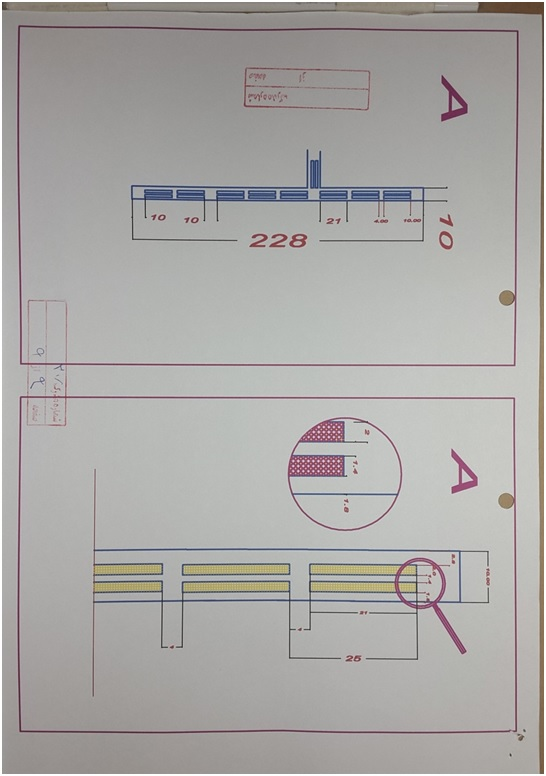
Figure 9. One option studied for fitting centrifuge cascades into the main tunnel of the enrichment plant. The magnifying glass and associated figure with four small circles in a line, where each circle represents individual centrifuges. The three larger circles represent space between centrifuges.
Enriched Uranium Output of the Al Ghadir Plant
Another archive document gives the capacity of the Al Ghadir plant as 45 kilograms per year of weapon-grade hexafluoride, according to Israeli briefers. This translates to about 30 kilograms of weapon-grade uranium (uranium mass). Assuming 15-20 kilograms of weapon-grade uranium per weapon, the plant’s output is enough to make one to two nuclear weapons per year.
This value appears relatively conservative for a plant with 3,000 IR-1 centrifuges organized into a three-step process to produce weapon-grade uranium. It appears to include realistic, even conservative inefficiencies in IR-1 centrifuge cascade operation. However, there remains a question if the weapon-grade uranium output would have been expected to be larger in other archive documents.
This annual value shows the problem of starting with natural uranium. If a four-step process had to be used, the plant’s output would drop to less than ten kilograms of weapon-grade uranium per year, where IR-1 centrifuge cascades are assumed to achieve outputs and efficiencies typical of the Natanz enrichment plant in the late 2000s and early 2010s. 16 In the Amad program, however, Iranian planners would likely have expected higher outputs of the IR-1. In this case, the Al Ghadir output would have been expected to be up to about 10 kilograms per year, but not enough for one nuclear weapon per year.
Post-Amad
There is a dearth of information about the Al Ghadir site from the end of the Amad Plan until its revelation in 2009. Commercial satellite imagery shows that work continued, although there may have been a lull in major tunneling operations at the tunnel complex in the 2004-2005 time period. In a June 6, 2004 Google Earth image, two covered tunnel entrances and a pile of earth spoils can be seen. A Google Earth image from March 24, 2005 shows the same two covered tunnel entrances and the pile of earth spoils (see Figure 10). There does not appear to have been much progress in either tunneling at this site or in further building the support area between these two dates. In subsequent years, construction accelerated.
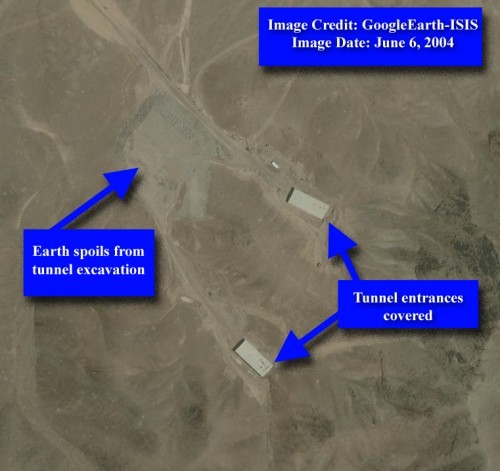
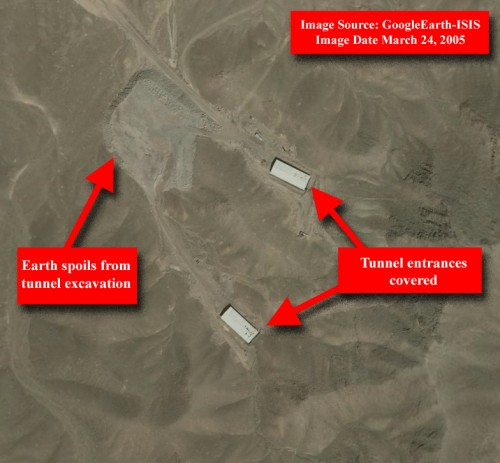
Figure 10. Google Earth images from June 6, 2004 and March 24, 2005. The same two covered tunnel entrances can be seen, as well as the pile of earth spoils. There does not appear to be much tunneling progress at this site between June 2004 and March 2005.
After Iran reoriented its nuclear weapons program, it at some point handed over the Al Ghadir site to the AEOI. This handover was likely similar to the one whereby the Gchine uranium mine and mill, discussed in an earlier Institute report, went from military to AEOI control. 17 However, in this case, the Iranians decided not to inform the IAEA about the site and subject it to monitoring.
One question is whether the Al Ghadir project represented one of the covert nuclear programs Iran decided to continue after the end of the Amad program. 18 In this case, deploying cascades designed to make weapon-grade uranium would have necessitated a covert, and not an overt effort, given that inspectors could discern the cascades’ purpose if they could enter the plant and see the cascade layout.
September 2009 Revelation
On September 25, 2009, then U.S. President Barack Obama, French President Nicolas Sarkozy, and British Prime Minister Gordon Brown stated that Iran had been building a secret enrichment site near Qom. This site is the Al Ghadir site.
Western intelligence had been suspicious that Iran had a secret uranium enrichment plant for some time. The allies, which include Britain, France, Israel, and the United States, had been aware of the site near Qom for many years, but labeled it an enigma site, where its purpose could not be agreed upon. One ally detected via satellite imagery in late 2007 work at the site that increased its suspicions about a possible nuclear use. 19 Another ally took this information and developed additional information, likely via human intelligence. In early 2009, the four allies had obtained information that led them to develop high confidence that the site housed a gas centrifuge plant that was under construction, with an expected operational date of 2010. 20 The information concerned the installation of the infrastructure for centrifuges, e.g. cascade piping, measuring equipment, and perhaps feed and withdrawal sections.
Although the site was under the control of the AEOI, it was known to only the most senior AEOI officials. 21 Iran went to great lengths to keep the plant secret. U.S. officials stated in the fall of 2009 that they did not know the “intent” of the facility, namely whether it was being designed to make weapon-grade uranium for nuclear weapons. 22
However, the U.S. view was that the “Iranians began this facility with the intent that it be secret, and therefore giving them an option of producing weapons-grade uranium without the international community knowing about it.” 23 Based on a series of statements at briefings and in interviews with one of the authors, the United States did not appear to have definitive information that the cascades were designed and configured to make weapon-grade uranium. 24
Design of the Centrifuge Plant in 2009
A critical question is whether the plant remained designed, post-Amad, to make weapon-grade uranium. At the time of its public revelation in September 2009, as discussed above, the United States stated it did not know the site’s intention. 25 However, key IAEA inspectors would relatively quickly come to a different conclusion. This conclusion has not been universally accepted, and some evidence contradicts it, but the inspectors’ conclusion remains the most convincing one.
Based on Iran’s statement to the IAEA, when inspectors first visited the new underground enrichment plant, they expected to find a plant that was dedicated solely to making less than five percent enriched uranium for civil purposes. 26 Upon arrival in late October 2009, they were shown two “halls” which would hold centrifuges inside the deeply buried complex. 27 It is unclear if there was a physical barrier between the halls, but two groupings of centrifuges were distinct from each other. Indeed, one hall, or portion of the tunnel complex, had centrifuge piping arrangements for cascades consistent with Iran’s declaration that LEU would be produced at the site. At that time, the centrifuges, called the IR-1, had not yet been installed, but trained inspectors can discern useful information about a cascade system by examining the piping.
Surprisingly, in the other hall, the Iranians were stripping out all the cascade piping and were cutting more rock to make additional space for what is called the feed section, namely where uranium is fed into the cascades in autoclaves. Iran told the inspectors that it was correcting mistakes, namely it forgot to paint the ceiling and needed bigger autoclaves. The latter are essentially ovens that heat tanks of uranium hexafluoride and turn it into a gaseous form for injection into cascades. By the time of the second visit two weeks later, all the pipework had been removed.
Inspectors viewed Iran’s actions as highly suspicious for such an experienced enrichment program; after all, it had operated the Natanz enrichment plant for several years and had installed a total of 8,300 IR-1 centrifuges there by September 2009. 28 If the second hall was for making weapon-grade uranium, going from 20 percent in two steps to 90 percent, the feed section would be relatively small, since the feed tanks and thus the associated autoclaves would be smaller to protect against accidental criticality. However, if the cascades were designed to make less than five percent LEU, the feed tanks containing natural uranium would be relatively large and would not have fit in the existing feed section in this area, and thus this part of the plant would have had to be enlarged, if it were to be modified to make LEU. This required that a larger space be excavated from the mountain. It appeared to some of the inspectors as if Iran was hiding evidence of plans to make weapon-grade uranium in this hall and was rapidly converting the plant from making weapon-grade uranium to low enriched uranium. Moreover, the piping in the other hall designed to make LEU would have been suitable for going from 3-4 percent to 20 percent enriched uranium, and not just enriching natural to 3-4 percent enriched uranium.
These observations contributed to several inspectors, including ones who were experts in gas centrifuges, becoming suspicious that this hall was for the onward enrichment of uranium up to weapon-grade. Adding to their suspicions, the sizes of the feed insertion and product removal areas (“takeoffs”), visible instrumentation, and other equipment were for a lower uranium hexafluoride gas flow and higher criticality conditions than found in cascades to make low enriched uranium. The assessment was that the Iranians were going to attach feed containers to these cascades that were enriched to greater than 20 percent. Some inspectors came to view that the first area was to enrich from about 3-5 percent to 20 percent, and the second area was to enrich in two steps from 20-60 percent and 60-90 percent.
Of course, Iran denied any such work. During this early period right after the plant was revealed, overly quick public statements added to the confusion. Then Director General of the IAEA, Mohammad El Baradei publicly downplayed the significance of the facility, calling it “nothing to be worried about.” 29 He added, “The idea was to use it as a bunker under the mountain to protect things” in case the Natanz enrichment site was bombed.30 At the time, the inspectors’ suspicions and assessments were not made public.
More recently, a key member state has discovered information, reportedly a cascade drawing, that it purports to be from 2007 that shows that LEU cascades were planned for Fordow by this date. The implication is that the AEOI would finish the plant, but as of 2007, it was being designed to make LEU, not weapon-grade uranium. However, this information, as currently understood, should be viewed critically. This information could be part of a “cover” created by the AEOI to camouflage its actions if it were caught, or an option for consideration if the plant was exposed and it needed to be reconfigured. The cascade information is dated to the same year that Iran declared it started construction of the plant, a clear misstatement. In that case, Iran could have prepared this design for the enrichment plant to back up its claim of starting construction of the plant in 2007. In addition, the AEOI may have simply had two designs for the plant, one to make LEU and the other to make weapon-grade uranium. Which was used would depend on circumstances. The inspectors’ information suggests that the design selected was the one to make weapon-grade uranium.
Where would Iran have acquired LEU for this plant, since its only domestic enrichment plant was under IAEA safeguards after 2002 and closely scrutinized by the international community? This raises a question, discussed in earlier Institute reports on the archive, whether Iran acquired LEU from abroad outside of safeguards. In addition, the Fordow enrichment plant may have been intended to only be used in the case of an Iranian breakout, in which case safeguarded LEU produced in Natanz would have been diverted to the new enrichment plant.
Iran’s Multiple Declarations Create Additional Skepticism
Iran subsequently increased suspicion about the original purpose of the site by changing its declarations about the centrifuges at the site, as if it was struggling to find a civilian justification for the enrichment plant. These changes played out in Iran’s filing of multiple “design information questionnaires” (DIQs), as detailed in IAEA reports.31 Certainly, countries can change their minds about the purpose of a nuclear facility. However, Iran altered the stated purpose of this enrichment facility so many times over such a short period of time that it merely added to questions regarding its original purpose.
According to IAEA safeguards reports, the first DIQ of October 10, 2009 stated that Fordow would produce uranium hexafluoride enriched up to five percent uranium-235 in 16 cascades containing about 3,000 centrifuges, and that the plant was a backup in case the Natanz enrichment site was bombed. This is the story ElBaradei told The New York Times. Iran did not explain why the Fordow site was considerably smaller than the Natanz Fuel Enrichment Plant.
The second DIQ, dated September 2010, changed the purpose from 16 cascades of centrifuges to eight cascades that would produce LEU below five percent uranium-235 and be located in one of the two underground cascade halls. 32 The second hall would have a research and development system for more advanced centrifuges.
The third DIQ in June 2011 changed the facility’s purpose again, stating that one hall composed of eight cascades of IR-1 centrifuges would be dedicated to making uranium enriched up to 20 percent. 33 Iran stated it had not yet decided on the purpose of the second hall, but it would likely hold advanced centrifuges, such as the IR-2m or IR-4 centrifuges then under development. Iran informed the IAEA that production of up to 20 percent enriched uranium would take place within two sets of two more efficient interconnected cascades, called “tandem” cascades. According to the media, Iran reportedly had decided to “triple its (production) capacity,” after which Iran would stop the “20 percent fuel production” at Natanz. 34 (It should be noted that Iran did not stop production of the near 20 percent enriched uranium at Natanz). 35
The fourth DIQ stated Fordow would be used for both 19.75 and 3.5 percent enriched uranium production. 36 However, it did not initially specify how many centrifuges would be dedicated to making 19.75 percent LEU.
During 2009 and into early 2012, each of the four DIQs stated a different purpose for the facility, according to the IAEA. 37 Overall, Iran appeared to be struggling to find a coherent civilian purpose for the site now called the Fordow enrichment site, given its extensive enrichment capabilities at the Natanz site. One fact was clear: Iran fully intended to bring this deeply buried enrichment plant into operation, regardless of the ambiguities in its declarations and the new requirement to design it for LEU only and place it under safeguards. In this regard, Iran followed a similar pattern seen in the case of the Gchine uranium mine and mill, namely once caught hiding a nuclear facility, it insisted that it was a civilian nuclear facility, denied any nuclear weapons connection, allowed IAEA inspections, and obfuscated, all the while bringing the plant into operation. 38 Although Iran had to also re-design the Fordow plant’s cascades to make LEU instead of weapon-grade uranium, it knew that with relatively minimal work it could adjust production from LEU back to weapon-grade uranium. For Iran, the Fordow site and earlier the Gchine uranium site were too important to Iran’s effort to develop a nuclear weapons capability to shut down. Calling them civilian and allowing inspections or monitoring was a price worth paying.
In the end, by early 2014 and the implementation of the Joint Plan of Action, which limited Iran’s nuclear program, Iran had installed approximately 2,700 first generation IR-1 centrifuges in the halls, called Units 1 and 2, each designed to hold 8 cascades of 174 centrifuges per cascade.39 According to IAEA safeguards reports on Iran, Iran operated 696 of these IR-1 centrifuges in four cascades of 174 IR1 centrifuges each that were organized in two tandem sets to produce near 20 percent low enriched uranium. 40
The Fordow facility continues to operate today, although under the 2015 Joint Comprehensive Plan of Action (JCPOA), its centrifuges are not enriching uranium. A relatively small number of them are dedicated to stable isotope separation in cooperation with Russia. The U.S. and allied negotiators were not able to convince Iran to shut down this site, even though it has no credible civilian nuclear justification. Moreover, Iran could reactivate the production of enriched uranium there relatively quickly.
IAEA Questions Remain
Like the United States and its allies, the IAEA in 2009 reportedly had been independently aware of the site for several years. However, it too was unable to definitely determine what was going on inside the tunnel complex and Iran did not declare it during the period of the Amad Plan or in fact until 2009, when it realized the plant had been exposed. Following this revelation, the IAEA was not able to confirm Iran’s chronology of the site’s construction. Moreover, it stated that it still had questions about the purpose of the facility and how it fit into Iran’s nuclear program. In the end, the IAEA and Iran did not agree on the actual start date for the Fordow enrichment site or its original purpose. 41 The IAEA continued to state that Iran needed to provide additional information about the facility. 42 In the last several years, the IAEA has reportedly gathered more details regarding the original development and purpose of this plant.
Conclusion
The Al Ghadir project was a vital, secret enrichment project under the Amad Plan. The archive demonstrates that the production of weapon-grade uranium for at least a few nuclear weapons per year was a priority for Iran.
During the Amad program, the military took over principal responsibility to make weapon-grade uranium, planning to build upon both the AEOI gas centrifuge capabilities and to depend on a portion of its low enriched uranium output. In that sense, by early 2003, the two parallel programs had become intertwined in a coherent fashion, with one aimed mainly at production of LEU and the other secret and focused on making weapon-grade uranium. But the military program depended for its success on the civilian nuclear project, particularly for an on-going source of low enriched uranium to feed into the Al Ghadir enrichment plant. This explicit connection between an ostensibly civilian enrichment program and a military nuclear weapons program, where the leadership defines their respective roles in making nuclear weapons, shows that the AEOI should not be looked upon as solely a civilian nuclear organization. The archive should be a warning that the functions of the AEOI could easily switch from civilian to military, if the regime makes a decision to build nuclear weapons.
This interchangeability, undoubtedly with the direction of senior Iranian leadership, can also be seen when, post-Amad, the AEOI after 2003 took over the Al Ghadir project when the military shed its explicitly nuclear fuel cycle tentacles. Although this enrichment plant came under the control of the AEOI, the evidence supports that the plant retained its design to make weapon-grade uranium up until it was revealed by Western intelligence in 2009. Because of the importance of this finding, it deserves more investigation.
The Al Ghadir project and its role in the Amad Plan, as far as we can determine, was not known to Western intelligence or the IAEA prior to the seizure of the archive in early 2018. Even after this project was transferred to the AEOI sometime after 2003, several years passed before its manifestation, namely as the enrichment site near Qom, was discovered by Western intelligence.
Transferring the Al Ghadir project to the AEOI but keeping its design to make weapon-grade uranium would be consistent with Iran’s decision to reorient the Amad Plan and downsize it, but not stop the nuclear weapons program. Building a plant designed to make weapon-grade uranium would qualify for a facility that needed to be kept secret under the reorientation plan. Undoubtedly, Iran calculated that if its work at the Al Ghadir enrichment site was discovered post-2004, it would deny any nuclear weapons connection, clean it up, and allow IAEA inspections. By having the AEOI own this site, the cover story of a civilian purpose would be more likely accepted by the international community or at least help mitigate the costs of discovery and help ensure its operation.
Iran’s determination to keep open this deeply buried enrichment site extended into the negotiations over the JCPOA and even today, despite the plant having no credible civilian nuclear justification. The Nuclear Archive raises again the deception of Iran about its past nuclear weapons activities and raises profound questions about the true purpose of this facility today and contingency plans for tomorrow, particularly when the nuclear limitations in the JCPOA end. That the international community has tolerated this continued existence of this plant speaks volumes of its failure to first determine and then ensure that Iran’s nuclear program is truly peaceful.
*Frank Pabian is a retired Los Alamos National Laboratory (LANL) Fellow from both the Global Security and Science-Technology-Engineering Directorates, most recently in the Geophysics Group, Earth and Environmental Sciences Division, with 45 years of experience in satellite remote sensing for nuclear nonproliferation. He also served in the 1990s as a United Nations Nuclear Chief Inspector in Iraq for the IAEA.
1. “10 facts about Al-Ghadir event by Ayatollah Khamenei,” Aug 30, 2018, http://english.khamenei.ir/news/5896/10-facts-about-Al-Ghadir-event-by-Ayatollah-Khamenei ↩
2. Ibid. ↩
3. See for example, IRNA, “Iran, holder of peaceful nuclear fuel cycle technology,” August 11, 2005, https://web.archive.org/web/20130810154009/http://www.mathaba.net/news/?x=302258t ↩
4. For example, see Albright, Peddling Peril (New York: Free Press, 2010). In particular, see statements of Masud Naraghi, p. 79 ↩
5. David Albright, Paul Brannan, and Andrea Stricker, The Physics Research Center and Iran’s Parallel Military Nuclear Program, Institute for Science and International Security, February 23, 2012, http://isis-online.org/uploads/isis-reports/documents/PHRC_report_23February2012.pdf ↩
6. Ibid. ↩
7. See for example, Peddling Peril, p. 79 ↩
8. David Albright, Olli Heinonen, and Andrea Stricker, “The Plan: Iran’s Nuclear Archive Shows it Originally Planned to Build Five Nuclear Weapons by mid-2003,” Institute for Science and International Security/Foundation for Defense of Democracies, November 20, 2018, http://isis-online.org/isis-reports/detail/the-plan-irans-nuclear-archive-shows-it-originally-planned-to-build-five-nu/8 ↩
9. Mark Heinrich, “New site shows Iran insists on enrichment,” Reuters. November 17, 2009, https://www.reuters.com/article/us-nuclear-iran-envoy/new-site-shows-iran-insists-on-enrichment-idUSTRE5AG21C20091117 ↩
10. An earlier version of this analysis, when fewer designs were available to us, is found in Albright and Frank Pabian, “It Fits! Qom Site Layout,” Institute for Science and International Security, May 1, 2018, http://isis-online.org/isis-reports/detail/it-fits-qom-site-layout/8 ↩
11. Briefing to Albright in Tel Aviv by senior Israeli officials, January 27, 2019 ↩
12. Briefing to Albright in Tel Aviv by senior Israeli officials, November 1, 2018. ↩
13. Albright and Paulina Izewicz, “Iran’s Centrifuge Research and Development Program,” Institute for Science and International Security, January 27, 2014, ↩
14. David Albright, Paul Brannan, and Jacqueline Shire, “Can Military Strikes Destroy Iran’s Gas Centrifuge Program? Probably Not,” Institute for Science and International Security, August 7, 2008, https://www.isis-online.org/publications/iran/Centrifuge_Manufacturing_7August2008.pdf ↩
15. Briefings by senior Israeli officials to Albright, June 6, 2018 and January 27, 2019. ↩
16. See for example, William C. Witt, Christina Walrond, David Albright, and Houston Wood, “Iran’s Evolving Breakout Potential,” Institute for Science and International Security, October 8, 2012. http://isis-online.org/uploads/isis-reports/documents/Irans_Evolving_Breakout_Potential.pdf The three-step process is not used here because the estimate in this report assumes that almost 100 kilograms of near 20 percent LEU are also fed into the third step of the plant, which significantly increases the output of weapon-grade uranium. ↩
17. David Albright, Olli Heinonen, Frank Pabian, and Andrea Stricker, “Anatomy of Iran’s Deception and How Iran Benefited: Iran’s Nuclear Archive Confirms Gchine Uranium and Yellowcake Production Plant were Originally Part of a Clandestine Nuclear Weapons Fuel Cycle. Yet, Gchine never stopped operating,” Institute for Science and International Security, December 19, 2018, http://isis-online.org/isis-reports/detail/anatomy-of-irans-deception-and-how-iran-benefited-irans-nuclear-archive-con ↩
18. David Albright, Olli Heinonen, and Andrea Stricker, “Breaking Up and Reorienting Iran’s Nuclear Weapons Program: Iran’s Nuclear Archive Shows the 2003 Restructuring of its Nuclear Weapons Program, then called the AMAD Program, into Covert and Overt Parts,” October 29, 2018, http://isis-online.org/isis-reports/detail/breaking-up-and-reorienting-irans-nuclear-weapons-program/8 ↩
19. Interview by Albright of senior U.S. government official, November 9, 2010. ↩
20. Briefing for Albright, September 25, 2009. ↩
21. “Background Briefing by Senior Administration Officials on Iranian Nuclear Facility,” White House, September 25, 2009. ↩
22. Ibid, and Interview by Albright of senior official, November 9, 2010. ↩
23. Background Briefing by Senior Administration Officials on Iranian Nuclear Facility, Pittsburg, Pennsylvania, September 25, 2009 ↩
24. Ibid, and Interview by Albright of senior European official, November 9, 2010. ↩
25. Ibid. ↩
26. IAEA press office, “Quotes from IAEA Spokesperson, Marc Vidricaire,” September 25, 2009. ↩
27. During its initial inspections in late October 2009, the IAEA found the centrifuge facility to be at “an advanced stage of construction” with “centrifuge mounting pads, header and sub-header pipes, water piping, electrical cables and cabinets” put in place but not yet connected. In addition, “passivation tanks, chemical traps, cold traps and cool boxes were also in place but had not been connected.” Inspectors also noted that a utilities building “containing electricity transformers and water chillers had also been erected.” See IAEA Director General, Implementation of the NPT Safeguards Agreement and relevant provisions of Security Council resolutions 1737 (2006), 1747 (2007), 1803 (2008) and 1835 (2008) in the Islamic Republic of Iran, GOV/2009/74, November 16, 2009, http://isis-online.org/uploads/isis-reports/documents/IAEA_Report_Iran_16November2009pdf_1.pdf ↩
28. David Albright, Paul Brannan, and Jacqueline Shire, “IAEA Report on Iran,” August 28, 2009, http://isis-online.org/uploads/isis-reports/documents/Analysis_IAEA_Report.pdf ↩
29. Roger Cohen, “Bunkers or Breakthrough?” The New York Times, November 5, 2009. > ↩
30. Ibid. ↩
31. The four DIQs summarized here are discussed in “Déjà Vu at Fordow? What are Iran’s Enrichment Plans?” by David Albright, Andrea Stricker, and Christina Walrond, Institute for Science and International Security, June 4, 2012, isis-online.org/isis-reports/detail/deja-vu-at-fordow-what-are-irans-enrichment-plans/8 ↩
32. Ibid. ↩
33. Ibid. ↩
34. “Iran to Triple Production of 20%-Enriched Uranium,” Fars News Agency, June 8, 2011. ↩
35. See for example: David Albright, Christina Walrond, and Andrea Stricker, “ISIS Analysis of IAEA Iran Safeguards Report,” November 14, 2013, http://isis-online.org/uploads/isis-reports/documents/ISIS_Analysis_IAEA_Safeguards_Report_14November2013-final.pdf ↩
36. “Déjà Vu at Fordow? What are Iran’s Enrichment Plans?” ↩
37. IAEA Director General, Implementation of the NPT Safeguards Agreement and relevant provisions of Security Council resolutions in the Islamic Republic of Iran, GOV/2013/27, May 22, 2013, footnote 23, http://isis-online.org/uploads/isis-reports/documents/IAEA_Iran_Safeguards_report_–_22May2013.pdf ↩
38. David Albright, Olli Heinonen, Frank Pabian, and Andrea Stricker, “Anatomy of Iran’s Deception and How Iran Benefited: Iran’s Nuclear Archive Confirms Gchine Uranium and Yellowcake Production Plant were Originally Part of a Clandestine Nuclear Weapons Fuel Cycle. Yet, Gchine never stopped operating,” Institute for Science and International Security/Foundation for Defense of Democracies, December 19, 2018 http://isis-online.org/isis-reports/detail/anatomy-of-irans-deception-and-how-iran-benefited-irans-nuclear-archive-con/8 ↩
39. David Albright and Serena Kelleher-Vergantini, “Update on Fordow Centrifuge Site: Future Uncertain,” Institute for Science and International Security, January 13, 2014, http://isis-online.org/uploads/isis-reports/documents/Fordow_Update_January_2014.p

 twitter
twitter